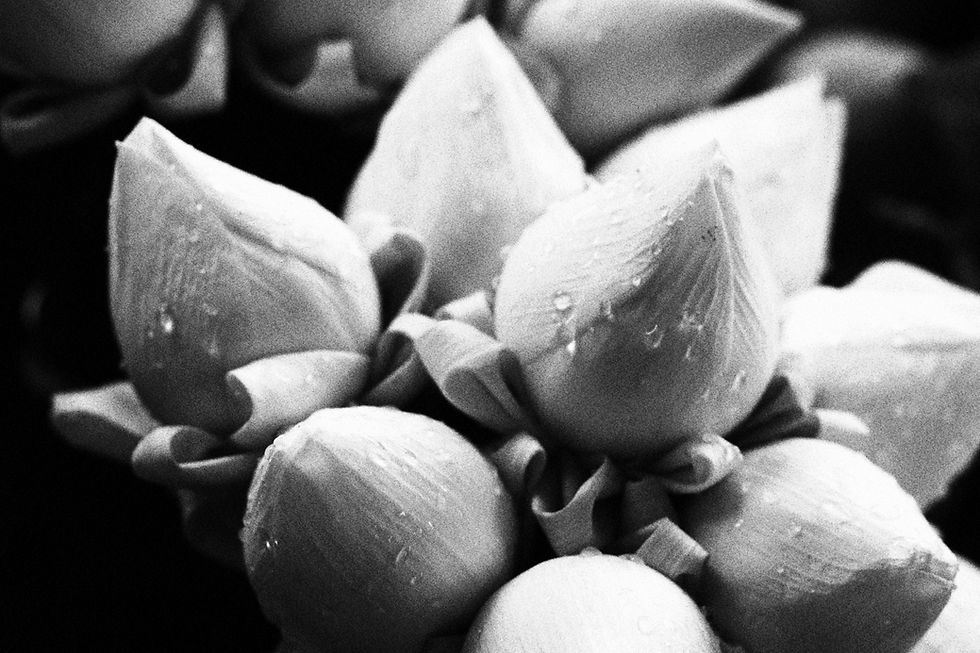When Nothing Happens, Something Still Might
- Tatiana Mocchetti
- Jun 20
- 4 min read
There are days when you go out to shoot and absolutely nothing seems to happen. The light is dull, the air feels still, and every corner you've once found magic in now looks plain. That was me, camera in hand, walking the backstreets of Chiang Mai with a plan to capture something—anything—that stirred me.
But nothing came. I wandered through alleys and shopfronts, paused near vendors, waited at crossings. My usual instinct, that subtle tug to lift the camera, was silent. The only sound was my own doubt whispering, “Why did you even bring your gear today?” The kind of day where inspiration hides behind closed shutters and your confidence starts to flicker. But still, I walked. Because part of photography—of life—is learning to keep going when things feel flat.
Trying to Make the Spark
On days like this, I’ve learned to trick my own eye. “Look for something yellow,” I told myself. Just that—nothing else. A monk’s robe, a faded sign, a plastic basket on a motorbike. Focusing on one color makes everything else fall away, and soon, the world feels less cluttered. It's a creative anchor, a way to stay engaged even when nothing calls out.
Sometimes, it’s not about the subject but about retraining your attention. I’ve tried looking only for reflections. Or only for people wearing hats. Or just hands—hands holding things, reaching, resting. The restriction sharpens your vision. It transforms the mundane into a scavenger hunt for beauty.
One Lens, One Frame
I’ve also tried limiting myself to a single frame. One photo for the next hour—just one. It shifts the whole rhythm. You slow down. You wait. You listen more than you look. The pressure to produce fades, and what rises instead is intention. Maybe you don’t get the shot, but you sharpen your patience. And that in itself is worth it.
This practice changes your relationship with the camera. Suddenly, it’s not about quantity—it’s about quality of attention. You begin to ask different questions: Why this moment? What makes it matter? And in those questions, you find the beginnings of a more thoughtful photograph.
Follow a Sound, Not a Sight
Another trick? Follow a sound. The clack of scissors, the beat of a broom on concrete, the distant chant of a radio. Let your ears lead. That’s how I once ended up at a hidden barbershop down a narrow soi, or behind a temple kitchen where monks were laughing over breakfast. Sound has a way of guiding you toward stories your eyes weren’t even searching for.
Or follow a smell—the scent of grilled meat, incense, or fresh laundry. Sensory photography. It’s not something often taught, but it’s real. These cues lead you not to the perfect frame but to a mood, a feeling, a sense of place. And often, that’s where the magic lies.
So I turned back, ready to call it a day.
And then I saw her.
She was leaning against a metal fence, half in shadow. Her blue dress faded but clean, her hair tied back with casual grace. One eye gently closed, the other meeting mine without hesitation. In her fingers, she rolled a traditional Thai cheroot—handmade, filled with tobacco and local herbs, a ritual held onto by older generations.
There was no rush in her. Just the slow, rhythmic motion of lighting the cheroot, taking a puff, and exhaling with a calm that seemed to settle the street itself. It wasn’t dramatic, but it was deeply human.
I nodded toward my camera. She smiled.
Click.
Click.
Click.
She laughed, playful and unbothered. She puffed again, and in that small cloud of smoke was a moment I couldn’t have planned. A moment that made the whole day worth it.
This is why I carry my camera, even on the uninspired days. Especially on the uninspired days. Because street photography isn’t about chasing drama—it’s about being present enough to catch poetry in the quiet.
She reminded me: the world doesn’t perform on cue. But it’s always there, unfolding, revealing, offering. Sometimes you just have to be still enough—and patient enough—to see it.
And every now and then, it shows up wrapped in a puff of smoke, grinning with one eye, and reminding you that the best photos aren’t always taken—they’re gifted.
"You just have to live and life will give you pictures." — Henri Cartier-Bresson
About the Thai Cheroot
The woman’s cigar was a Thai cheroot, or khi yo—a hand-rolled local cigar made from dried tobacco leaves, often blended with tamarind bark, herbs, or banana leaf. Common in northern Thailand and Myanmar, especially among the older generation, it’s more than a habit—it’s a cultural signature. Watching her light it, smoke it, and hold it without pretense was like witnessing a fading ritual come to life.
The scent is earthy and rich, unlike anything mass-produced. The way she held it, with familiarity and care, added to the impression that this wasn’t just smoking—it was memory, tradition, and identity wrapped into a small gesture.
Street photography isn’t always about the perfect light or subject—it’s about showing up. It’s about being willing to walk empty-handed for hours and still trust that something meaningful will reveal itself. And when it does, it humbles you.
So if your next walk feels quiet, don’t give up.
Look for color. Follow sound. Watch for movement. Let yourself slow down.
The frame you’ll remember most might be waiting for you on the way back.
Cheroot in hand. Smile in the corner of one eye. Ready for your lens.











Comments